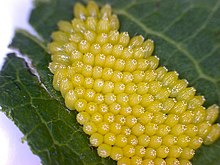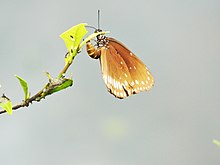Egg
Egg
 |
| Eggs of black-veined white (Aporia crataegi) on apple leaf |
Butterfly eggs are protected by a hard-ridged outer layer of shell, called the chorion. This is lined with a thin coating of wax which prevents the egg from drying out before the larva has had time to fully develop. Each egg contains a number of tiny funnel-shaped openings at one end, called micropyles; the purpose of these holes is to allow sperm to enter and fertilize the egg. Butterfly eggs vary greatly in size and shape between species, but are usually upright and finely sculptured. Some species lay eggs singly, others in batches. Many females produce between one hundred and two hundred eggs.[38]
Butterfly eggs are fixed to a leaf with a special glue which hardens rapidly. As it hardens it contracts, deforming the shape of the egg. This glue is easily seen surrounding the base of every egg forming a meniscus. The nature of the glue has been little researched but in the case of Pieris brassicae, it begins as a pale yellow granular secretion containing acidophilic proteins. This is viscous and darkens when exposed to air, becoming a water-insoluble, rubbery material which soon sets solid.[39] Butterflies in the genus Agathymus do not fix their eggs to a leaf, instead the newly laid eggs fall to the base of the plant.[40]
Eggs are almost invariably laid on plants. Each species of butterfly has its own host plant range and while some species of butterfly are restricted to just one species of plant, others use a range of plant species, often including members of a common family.[41] In some species, such as the great spangled fritillary, the eggs are deposited close to but not on the food plant. This most likely happens when the egg overwinters before hatching and where the host plant loses its leaves in winter, as do violets in this example.[42]
The egg stage lasts a few weeks in most butterflies, but eggs laid close to winter, especially in temperate regions, go through a diapause (resting) stage, and the hatching may take place only in spring.[43] Some temperate region butterflies, such as the Camberwell beauty, lay their eggs in the spring and have them hatch in the summer.[44]
 |
| A butterfly laying eggs underneath the leaf |
Comments
Post a Comment